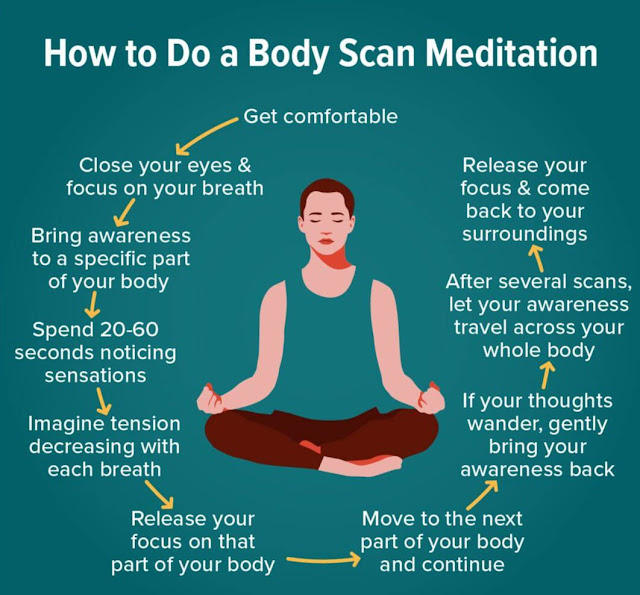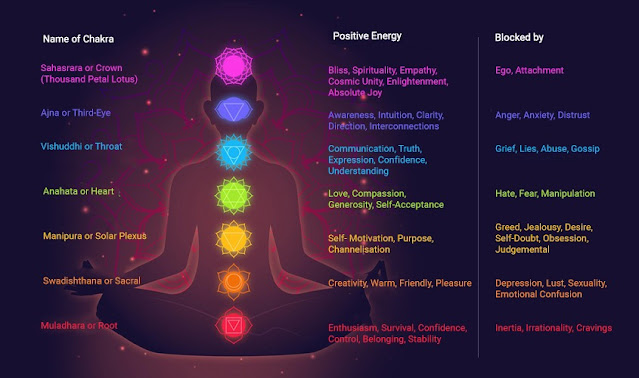Body Scan Meditation
Namaste,
Body Scan Meditation is a transformative practice that encourages a deep connection between the mind and body. Rooted in mindfulness, Body Scan Meditation involves a systematic exploration of sensations, starting from the top of the head and slowly moving down to the toes. During Body Scan Meditation, one progressively brings attention to each part of the body, acknowledging sensations without judgment. This technique allows individuals to tune into their body's signals, promoting relaxation, stress reduction, and heightened self-awareness. Body Scan Meditation serves as a powerful tool to release tension, increase mindfulness, and foster a profound sense of presence in each moment. Through the deliberate focus on the body's sensations, Body Scan Meditation offers a pathway to inner calmness and holistic well-being.
In our previous posts, we took a little closer look at...
Meditation Meaning, History of Meditation, Guided Mindfulness Meditation, Movement Meditation, Spiritual Meditation, Focused Meditation, Mantra Meditation, Transcendental Meditation, Vipassana Meditation, Visualization Meditation, Progressive Relaxation Meditation, Loving-kindness meditation, Deep breathing exercises and it's Benefits, Relaxation exercises, Yoga meditation, Zen meditation, Chakra Meditation, Qigong Meditation, Sound Bath Meditation, and Guided Imagery and Visualization.
Now we take a step forward with the same topic. Now we try to explore a different type of meditation, called Body Scan Meditation.
 |
| Body Scanned Meditation |
What is body scan meditation?
Body scan meditation is a type of mindfulness meditation in which you focus your attention on different parts of your body, from your toes to your head. As you scan your body, you pay attention to any sensations you feel, such as itching, pain, or warmth. You may also focus on your breath and how it feels as it moves in and out of your body.
The goal of body scan meditation is to increase your awareness of your body and to help you relax. Although it may take some practice to master, body scan meditation can be a helpful tool for managing stress and anxiety.
How to do a Body Scan Meditation?
Mindfulness meditation is a form of mindfulness that is widely practiced in the western world. It is a simple, effective way to focus and calm the mind, and has been shown to be beneficial for both mental and physical health.
The body scan is a type of mindfulness meditation that involves systematically scanning the body from head to toe, noticing and accepting any sensations that arise. This practice can help to reduce stress and anxiety, and promote a sense of well-being.
Here is a step-by-step guide to doing a body scan meditation:
- Find a comfortable place to sit or lie down. You may want to use a pillow or blanket to support your back.
- Close your eyes and take a few deep breaths.
- Begin to notice the sensations in your body, starting with your feet. Notice any sensations of cold, warmth, tingling, or pressure.
- Slowly move up through your body, noticing the sensations in your legs, torso, arms, hands, neck, and face.
- As you notice each sensation, simply label it as “cold,” “warm,” “tingling,” “pressure,” etc. without judging or trying to change it.
- If your mind wanders, simply notice where it went and gently bring your attention back to the sensations in your body.
- When you’re finished, take a few deep breaths and open your eyes.
What are the different stages of Body Scan Meditation?
There are four different stages of a body scan meditation:
- Preparation: In this stage, you will find a comfortable place to sit or lie down. You may want to close your eyes and take a few deep breaths to help you relax.
- Focusing on your breath: Once you are settled, begin to focus your attention on your breath. Notice the sensation of the air moving in and out of your nose and lungs.
- Scanning your body: Once you are focused on your breath, begin to scan your body from your toes to your head. Notice any areas of tension or stress. See if you can breathe into these areas and release the tension.
- Ending the meditation: When you are ready, slowly open your eyes and take a few deep breaths. Thank yourself for taking the time to meditate.
 |
| How to do Body Scan Meditation? |
How to progress in Body Scan Meditation?
When you first start practicing body scan meditation, it is common to feel like you are not making progress. However, with regular practice, you will slowly but surely start to feel more comfortable with the practice. Here are a few tips on how to progress in body scan meditation:
- Set aside some time each day to practice. It doesn't have to be a long time, even 10-15 minutes will do. The important thing is to be consistent.
- Start by focusing on your breath. Once you have a comfortable rhythm, start to scan your body from head to toe. Pay attention to any areas of tension or discomfort.
- As you progress, you can start to focus on specific areas of the body. For example, you might spend a few minutes focusing on the muscles in the shoulders and neck.
- Remember to be patient and gentle with yourself. This is a practice that takes time and patience to master.
With regular practice, you will slowly but surely start to see progress in your body scan meditation. Be patient and gentle with yourself, and eventually you will be able to find a deeper sense of peace and relaxation.
When to do Body Scan Meditation?
There is no one answer to this question - it depends on what works for you. Some people find that body scan meditation is most effective when done first thing in the morning, before starting their day. Others find that it works better for them to do it at night, before going to bed. And still others find that doing a body scan meditation at lunchtime or in the afternoon works best for them.
The key is to experiment and find what works best for you. There is no wrong time to do body scan meditation - it is simply a matter of finding the time that works best for you and your schedule.
Where to do Body Scan Meditation?
There are many different ways to do body scan meditation. You can do it lying down, sitting, or even standing. You can do it with your eyes open or closed.
The most important thing is to be comfortable. If you are uncomfortable, it will be difficult to focus your attention on your body.
Once you are comfortable, you can begin the body scan. Start by focusing your attention on your toes. Notice how they feel. Are they warm or cold? Are they tingling or numb?
Move your attention up to your feet, then your ankles, your calves, your knees, and so on, until you have reached your head. As you move your attention from one body part to the next, notice how each part feels.
Pay attention to any sensations you feel, such as itchiness, pain, or tension. Don't try to change anything, just observe.
When you reach your head, take a few deep breaths and then slowly open your eyes.
Body scan meditation can be a helpful practice for reducing stress and anxiety, improving sleep, and increasing body awareness. It is best to practice body scan meditation for 10-15 minutes per day.
 |
| Body Scan Meditation |
What are the Benefits of Body Scan Meditation?
Body scan meditation is a mindfulness practice in which you focus your attention on different parts of your body, systematically noticing any sensations you feel in each area.
Benefits of body scan meditation include:
1. Reducing stress and tension: When you focus on your breath and the sensations in your body, you can let go of worry and stress. This can lead to a reduction in physical symptoms of stress, such as muscle tension and headaches.
2. Improving sleep: By focusing on relaxation and letting go of stress and anxiety, body scan meditation can help you fall asleep more easily and sleep more soundly.
3. Easing pain: Body scan meditation can help you become more aware of pain and discomfort in your body, and also help you to release tension and relax tight muscles. This can lead to a reduction in chronic pain, as well as relief from acute pain such as headaches and menstrual cramps.
4. Boosting mood and well-being: The relaxation response elicited by body scan meditation can help to boost your mood and promote a sense of well-being.
5. Improving concentration and focus: The regular practice of body scan meditation can help to improve your concentration and focus, as well as your ability to pay attention and stay present in the moment.
6. Supporting your immune system: The relaxation response elicited by body scan meditation can help to support the function of your immune system.
7. Reducing blood pressure: The relaxation response elicited by body scan meditation can help to lower blood pressure.
8. Slowing heart rate: The relaxation response elicited by body scan meditation can help to slow your heart rate.
9. Improving breathing: The relaxation response elicited by body scan meditation can help to improve your breathing.
Scientific Studies about Body Scan Meditation
Body scan meditation is a type of mindfulness meditation that involves paying attention to sensations in your body. It can help you relax, cope with stress, pain, and emotions, and improve your well-being. Here are some scientific proofs of the benefits of body scan meditation:
- A 2019 review suggests mindfulness meditation, including body scan, may help reduce the impact of some types of sleep issues and improve sleep quality ↂ.
- A meta-analysis from 2021 suggests that mindfulness and meditation, such as body scan, have the potential to reduce stress and anxiety symptoms ↂ.
- A 2017 review of 13 studies suggests mindfulness meditation, including body scan, can help reduce effects associated with chronic pain, such as depression or decreased quality of life ↂ.
- A number of studies have found that people who practice body scan meditation experience greater levels of self-awareness, mindfulness, and psychological well-being ↂ.
- A study from 2018 suggests that body scan meditation can enhance self-compassion and reduce self-criticism among college students ↂ.


















.jpg)

